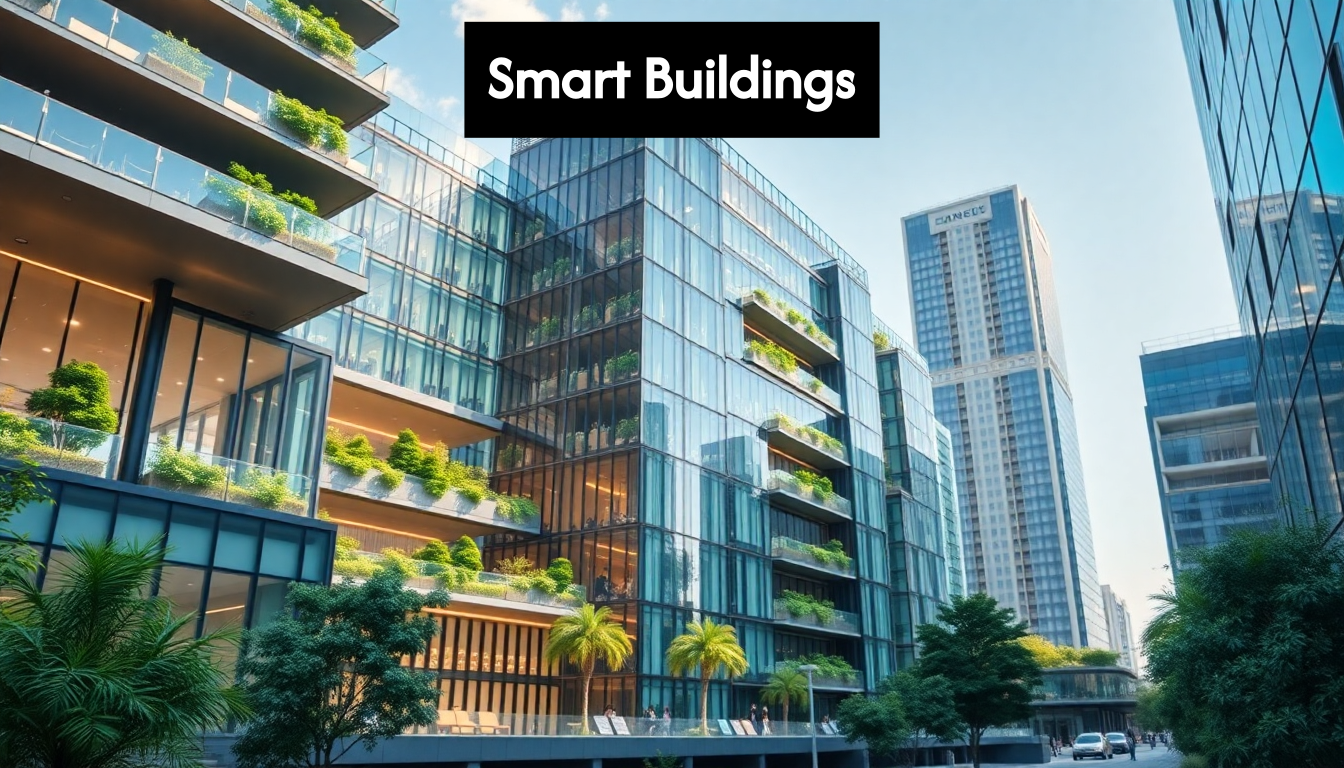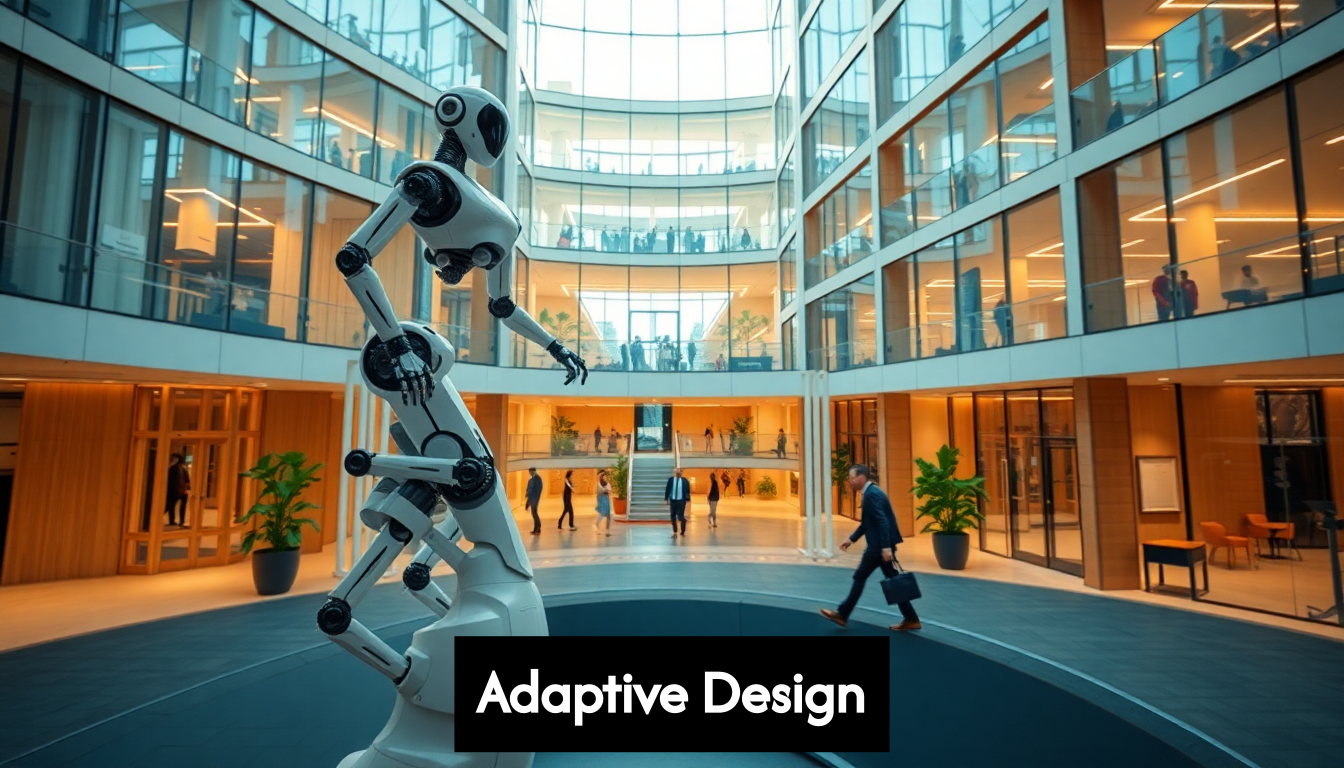
Smart buildings are reshaping how we think about energy use and comfort in our environments. Did you know that according to a study by the University of British Columbia, buildings account for approximately 32% of global energy use and 19% of CO2 emissions? This stark reality might suggest an urgent need for change. But here’s the twist: the future of buildings doesn’t just lie in reducing energy consumption; it’s about creating environments that actively enhance the lives of their occupants. As we delve into the world of smart building technologies, prepare to discover solutions that offer sustainable efficiency while promoting wellbeing and productivity.
Understanding Smart Building Concepts
The concept of smart buildings has evolved significantly over the past decade, transforming from basic automated systems to comprehensive, integrated technological ecosystems. At their core, smart buildings leverage advanced technologies to enhance building performance, occupant comfort, and operational efficiency.
What Defines a Smart Building?
A smart building utilises interconnected technologies to monitor, manage and optimise various building systems. Unlike conventional buildings that operate with isolated mechanical and electrical systems, smart buildings integrate these components through sophisticated digital infrastructure.
According to research from the University of British Columbia, buildings account for approximately 32% of global energy use and 19% of CO2 emissions, highlighting why the shift towards intelligent building management has become increasingly crucial. This environmental impact underscores the importance of smart building technologies in our collective efforts to reduce carbon footprints.
The fundamental characteristics that define a smart building include:
- Interconnectivity between various building systems (HVAC, lighting, security, etc.)
- Real-time data collection through sensors and IoT devices
- Automated responses to changing conditions within the building environment
- Analytics capabilities that transform raw data into actionable insights
Smart buildings transcend simple automation. While automated buildings might have programmable systems that follow predetermined schedules, truly intelligent buildings continuously learn from occupant behaviour and environmental conditions, adapting their operations accordingly.
The Evolution of Building Intelligence
The journey towards smart buildings has progressed through several distinct phases. Initially, building management systems (BMS) allowed for basic monitoring and control of individual systems. The current generation of smart buildings, however, represents a quantum leap in capability.
Modern smart building technologies combine artificial intelligence, machine learning, and robust data analytics to create adaptive environments that respond to both explicit commands and implicit needs. These technologies have transformed buildings from passive infrastructures into dynamic, responsive entities capable of making autonomous decisions.
The integration potential continues to expand as the Internet of Things (IoT) becomes more sophisticated. Today’s smart building might contain thousands of sensors monitoring everything from air quality and temperature to occupancy patterns and equipment performance. These sensors generate valuable data streams that feed into central management systems, creating a comprehensive picture of building operations.
The Smart Building Ecosystem
The technological framework of a smart building consists of three principal layers:
-
Physical infrastructure – The hardware components including sensors, actuators, and connected devices that collect data and execute commands
-
Network infrastructure – Communication protocols and systems that enable data exchange between devices and central management systems
-
Application layer – Software platforms that analyse data, visualise information, and automate responses based on predefined parameters or AI-driven decisions
This layered approach creates a cohesive ecosystem where information flows seamlessly between systems, enabling holistic building management rather than siloed operations. The result is a building that not only responds to immediate needs but anticipates future requirements based on historical patterns and predictive analytics.
Understanding the core concepts behind smart buildings provides the foundation for exploring their specific technologies, applications, and benefits. As we advance, the distinction between a building that simply houses smart technologies and a genuinely intelligent building becomes increasingly important in developing truly effective smart building solutions.
Key Takeaways
| Takeaway | Explanation |
|---|---|
| Interconnectivity is crucial | Smart buildings leverage interconnected technologies across various systems (HVAC, lighting, security) to enhance efficiency and occupant comfort, unlike conventional buildings that operate in isolation. |
| AI and IoT are foundational | The integration of AI and IoT devices allows for real-time data collection and analysis, enabling predictive maintenance and optimised energy consumption, which are key for operational efficiency. |
| Energy efficiency leads to cost savings | Smart building technologies significantly reduce energy consumption by 20-30%, leading to lower operational costs and diminished environmental impact, making investment in these technologies economically beneficial. |
| Focus on occupant experience | By enabling personalised comfort controls and improving indoor air quality, smart buildings can enhance user satisfaction and wellbeing, which are critical for talent attraction and retention. |
| Future-proofing through technology | Investing in smart building technologies positions properties to adapt to changing regulations and market expectations, ensuring long-term competitiveness and value. |

Key Technologies Transforming Buildings
Smart building technologies represent a diverse ecosystem of interconnected systems and devices that work together to create intelligent, responsive built environments. These technologies form the backbone of modern smart buildings, enabling automation, optimisation, and enhanced user experiences. Let’s explore the fundamental technologies driving the smart building revolution.
Internet of Things (IoT) and Sensing Technologies
At the foundation of any smart building is a robust network of sensors and IoT devices. These technologies serve as the building’s nervous system, constantly collecting data about the environment and occupant behaviour.
Smart buildings typically employ various sensors, including:
- Occupancy sensors that detect the presence of people in spaces
- Environmental sensors measuring temperature, humidity, air quality, and light levels
- Energy meters monitoring electricity, water, and gas consumption
- Access control systems tracking movement throughout the building
These sensors generate continuous data streams that feed into central management systems. The true power of IoT in smart buildings lies not just in the individual sensors but in their interconnectivity. When thousands of data points work in concert, they create a comprehensive picture of building operations that would be impossible to achieve manually.
Artificial Intelligence and Machine Learning
The vast amounts of data generated by IoT devices would be overwhelming without sophisticated analysis tools. This is where artificial intelligence and machine learning become crucial components of smart building technology.
AI systems can identify patterns in building usage, predict maintenance needs, optimise energy consumption, and even learn occupant preferences over time. For example, machine learning algorithms might recognise that a particular conference room is consistently overbooked on Tuesdays, suggesting the need for alternative scheduling approaches or space utilisation.
Predictive maintenance represents one of the most valuable applications of AI in smart buildings. By analysing performance data from building systems, AI can identify potential failures before they occur, allowing maintenance teams to address issues proactively rather than reactively. This capability significantly reduces downtime and extends the lifespan of building equipment.
Building Management Systems (BMS)
The nerve centre of a smart building is its building management system—a centralised platform that integrates and controls various building functions. Modern BMS platforms have evolved from simple control systems to sophisticated digital twins that provide comprehensive visibility into all building operations.
A state-of-the-art BMS typically offers:
- Real-time monitoring of all connected systems
- Automated control of HVAC, lighting, and security systems
- Energy management capabilities
- Integration with workplace management software
- User interfaces for both building managers and occupants
What distinguishes today’s smart building management systems from their predecessors is their ability to facilitate interoperability between previously siloed systems. Rather than separate controls for HVAC, lighting, and security, a modern BMS orchestrates these systems in harmony, enabling them to work together toward common goals like energy efficiency or occupant comfort.
Adaptive Architecture and Robotics
An emerging frontier in smart building technologies is the integration of robotic systems and adaptive architecture. According to recent research from the University of Nottingham, adaptive architecture incorporates robotic technology to physically alter building spaces based on occupant needs, potentially improving satisfaction, comfort, and wellbeing in multi-occupancy buildings.

These systems represent the next evolution in smart buildings—moving beyond digital control to physical adaptation. Examples include automated shading systems that respond to sunlight patterns, modular walls that reconfigure based on space requirements, and even furniture that adjusts to different users’ ergonomic needs.
This integration of physical and digital systems exemplifies the convergence of traditional building design with cutting-edge technology, creating spaces that can transform themselves to meet changing requirements.
The technologies transforming our buildings today are not merely about automation but about creating responsive, intelligent environments that adapt to human needs. As these technologies continue to evolve and integrate, the distinction between a building and its technology will increasingly blur, creating truly intelligent built environments that serve their occupants in ways previously unimaginable.
Benefits of Smart Building Solutions
Smart building technologies deliver substantial advantages across multiple dimensions, from operational efficiency to occupant experience. These benefits extend beyond immediate cost savings to create long-term value for building owners, managers, and users alike. Understanding these advantages is essential for organisations considering investments in smart building solutions.
Enhanced Energy Efficiency and Sustainability
Perhaps the most compelling benefit of smart building technologies is their capacity to significantly reduce energy consumption and associated carbon emissions. According to research published in MDPI Electronics, IoT-enabled smart buildings can optimise energy usage in real-time based on occupancy patterns and demand, substantially reducing environmental impact.
Smart buildings achieve enhanced energy efficiency through multiple mechanisms:
- Demand-responsive HVAC systems that adjust cooling and heating based on actual occupancy rather than rigid schedules
- Intelligent lighting controls that dim or switch off lights in unoccupied spaces
- Automated window shading that maximises natural light while minimising solar heat gain
- Equipment power management that reduces phantom energy loads during inactive periods
These systems work in concert to create a continuously optimised environment. For instance, when sensors detect that a conference room is empty, the building management system can automatically adjust temperature setpoints, turn off lights, and power down presentation equipment—all without human intervention.
The cumulative effect of these optimisations is substantial. Smart buildings typically achieve energy reductions of 20-30% compared to conventional buildings, representing not just environmental benefits but significant operational cost savings.
Improved Operational Efficiency
Beyond energy savings, smart building technologies dramatically enhance overall operational efficiency. Traditional building management often relies on reactive approaches—responding to issues after they occur. Smart building solutions flip this paradigm by enabling proactive and predictive management.
Key operational benefits include:
- Reduced maintenance costs through predictive maintenance that identifies potential equipment failures before they occur
- Extended asset lifecycles by ensuring equipment operates within optimal parameters
- Optimised space utilisation through occupancy analytics that reveal how spaces are actually used
- Streamlined facilities management with centralised controls and automated workflows
The data-driven insights provided by smart building systems also enable more strategic decision-making. Rather than relying on assumptions or limited observations, facilities managers can access comprehensive analytics about building performance and utilisation patterns. This information supports evidence-based decisions about everything from space planning to capital investments.
Enhanced Occupant Experience and Wellbeing
While the operational benefits of smart buildings are compelling, the impacts on occupant experience may ultimately prove even more valuable. Smart building technologies create environments that are more comfortable, healthier, and more responsive to user needs.
Personalised comfort control represents one of the most appreciated occupant benefits. Through smartphone apps or other interfaces, building users can adjust temperature, lighting, or other environmental factors to suit their preferences. These systems can even learn individual preferences over time, automatically creating optimal conditions for specific users.
Health and wellbeing benefits include:
- Improved indoor air quality through intelligent ventilation systems that adjust based on CO2 levels and other pollutants
- Optimised lighting conditions that support circadian rhythms and reduce eye strain
- Noise management solutions that create more productive acoustic environments
- Touchless experiences that reduce disease transmission and enhance convenience
These improvements in the indoor environment directly translate to measurable benefits for organisations, including reduced absenteeism, enhanced productivity, and improved talent attraction and retention. In competitive labour markets, the quality of workspace has become a significant differentiator for employers.
Future-Proofing and Value Creation
Perhaps most importantly, investments in smart building technologies future-proof properties against changing regulations, market expectations, and technological developments. As sustainability and wellness standards become increasingly stringent, buildings with advanced technological capabilities will maintain their competitive edge and value proposition.
Smart buildings also offer enhanced flexibility to adapt to changing operational requirements—a benefit that became particularly apparent during the COVID-19 pandemic when occupancy patterns and space requirements changed dramatically. Buildings equipped with advanced sensing and management systems could adapt more readily to these shifts, providing valuable operational resilience.
The benefits of smart building solutions extend far beyond immediate cost savings to create multifaceted value through operational excellence, enhanced occupant experience, and long-term competitive advantage. As these technologies continue to mature and integrate, their capacity to deliver these benefits will only increase, making smart building investments increasingly essential for forward-thinking organisations.
Future Trends in Building Automation
The landscape of smart building technologies continues to evolve rapidly, with innovations pushing the boundaries of what’s possible in building automation. As we look toward the horizon, several key trends are emerging that will likely shape the next generation of smart buildings. These developments promise to further enhance efficiency, sustainability, and user experience while addressing current limitations.
AI-Powered Predictive Building Control
Artificial intelligence is transforming from a supplementary tool to a central driving force in building automation. Advanced AI algorithms are increasingly capable of not just responding to conditions but anticipating needs and optimising systems proactively.
According to research published in the Journal of Building Engineering, AI-based building control systems have demonstrated energy savings ranging from 21.81% to 44.36% while simultaneously improving occupant comfort by 21.67% to 85.77%. These impressive gains highlight why AI adoption is accelerating across the building sector.
The next wave of AI implementation will likely feature:
- Digital twins that create comprehensive virtual replicas of buildings, enabling complex simulations and scenario testing
- Reinforcement learning algorithms that continuously improve building performance through trial-and-error processes
- Natural language interfaces that allow occupants and facility managers to interact with building systems through conversation
- Computer vision systems that can interpret visual information to enhance security, occupancy detection, and space utilisation
As these AI systems mature, they will increasingly operate autonomously, requiring minimal human intervention while delivering superior performance across all building systems.
Edge Computing and Distributed Intelligence
Traditional building automation systems often rely on centralised processing, with data travelling to cloud servers for analysis. The future points toward more distributed intelligence through edge computing—processing data closer to where it’s generated.
This shift toward edge computing offers several critical advantages:
- Reduced latency for time-sensitive functions like security and access control
- Enhanced reliability through less dependence on constant network connectivity
- Improved privacy by keeping sensitive data local rather than transmitting it externally
- Lower bandwidth requirements as only processed insights rather than raw data need transmission
In practice, this means more intelligence embedded directly in building devices and local controllers. A lighting sensor might not just detect motion but process occupancy patterns locally, communicating only high-level insights to central systems. This distributed approach creates more resilient and responsive building networks while addressing growing concerns about data privacy and security.
Integration Between Buildings and Urban Systems
The boundaries between individual smart buildings and broader urban systems are blurring. Future building automation will increasingly connect with and respond to urban infrastructure, creating a seamless ecosystem of information exchange and coordinated operation.
Emerging examples of this integration include:
- Smart grid interaction where buildings dynamically adjust energy usage based on grid conditions
- Integration with public transportation systems to optimise building operations around arrival patterns
- Coordination with municipal water and waste management systems for more efficient resource utilisation
- Participation in district-level energy sharing and thermal exchange networks
This integration reflects a recognition that buildings don’t exist in isolation but are vital components of urban ecosystems. The most advanced smart buildings will not only manage their internal systems efficiently but will also serve as nodes in larger networks of urban intelligence.
Human-Centred Automation
While early building automation focused primarily on operational efficiency, future systems will place increasing emphasis on human experience. This shift recognises that buildings ultimately exist to serve people, and technology should enhance rather than complicate human interaction with built environments.
Emerging human-centred approaches include:
- Biophilic integration that combines technology with natural elements to support wellbeing
- Adaptive environments that learn individual preferences and adjust accordingly
- Intuitive interfaces that simplify interaction with complex building systems
- Wellness-oriented automation that optimises conditions for human health beyond basic comfort
This trend acknowledges that the ultimate measure of a smart building’s success isn’t just energy savings or operational efficiency but its ability to create environments where people thrive. The most successful building automation systems will balance technological sophistication with human-centred design principles.
Sustainability Beyond Energy
While energy efficiency remains a cornerstone of smart building technology, future automation systems will address sustainability more holistically. This expanded focus encompasses water conservation, waste reduction, materials management, and even indoor environmental quality as components of a comprehensive sustainability approach.
Emerging technologies in this space include:
- Advanced water management systems that detect leaks, optimise irrigation, and facilitate greywater reuse
- Smart waste systems that track disposal patterns and optimise collection
- Air quality monitoring and remediation technologies that maintain healthy indoor environments
- Carbon tracking tools that measure and help manage a building’s overall environmental footprint
As buildings face increasing pressure to minimise environmental impact, automation systems will expand to address all aspects of resource consumption and environmental health. The smartest buildings will optimise operations not just for financial performance but for ecological stewardship as well.
The future of building automation lies at the intersection of artificial intelligence, distributed processing, urban integration, human-centred design, and comprehensive sustainability. As these trends continue to develop and converge, they will reshape our expectations of what buildings can do and how they can serve both occupants and the planet.
Frequently Asked Questions
What are smart building technologies?
Smart building technologies refer to interconnected systems and devices that enhance building performance, efficiency, and occupant comfort through automation and real-time data analytics.
How do smart buildings improve energy efficiency?
Smart buildings utilize IoT sensors and AI-driven systems to optimise energy consumption by adjusting HVAC and lighting based on occupancy and environmental conditions, resulting in energy savings of 20-30%.
What benefits do smart buildings offer for occupants?
Smart buildings enhance occupant experience by providing personalised comfort controls, improving indoor air quality, and creating healthier work environments, which can lead to increased productivity and wellbeing.
Can smart building technologies help with security?
Yes, smart building technologies improve security through integrated access control systems, real-time monitoring, and data analytics, enabling proactive responses to potential threats and ensuring occupant safety.
Transform Your Space Into a Smart Building with Re-Solution
As the world evolves towards energy-efficient, responsive environments, your building must not be left behind. The article on smart building technologies highlights how these innovations can enhance efficiency, sustainability, and occupant satisfaction. But the question remains: how can you implement these transformative technologies in your own facilities?
At Re-Solution, we recognise the challenges that come with integrating smart solutions—whether it’s ensuring compliance, enhancing security, or optimising connectivity. With over 35 years of experience and as a trusted Cisco partner, we provide tailored managed IT services, Network as a Service (NaaS), and security solutions specifically designed to meet the diverse needs of sectors like education, logistics, and hospitality. Our proven approach ensures you not only meet today’s requirements but are also future-proofed for tomorrow’s innovations.

Don’t let your property fall behind in the smart building revolution. Visit Re-Solution to discover how our bespoke solutions can elevate your building’s performance and occupant experience. Act now and transform your spaces into intelligent environments that enhance both efficiency and security. Your journey to a smarter building starts today!
